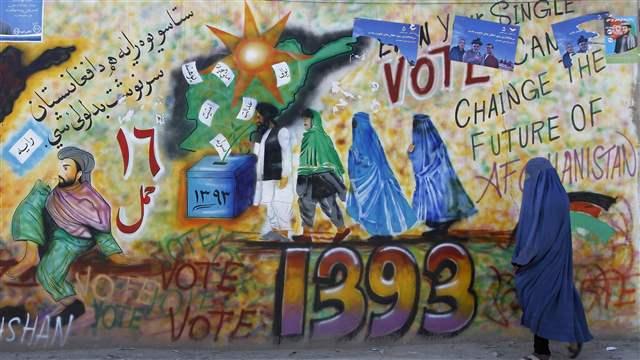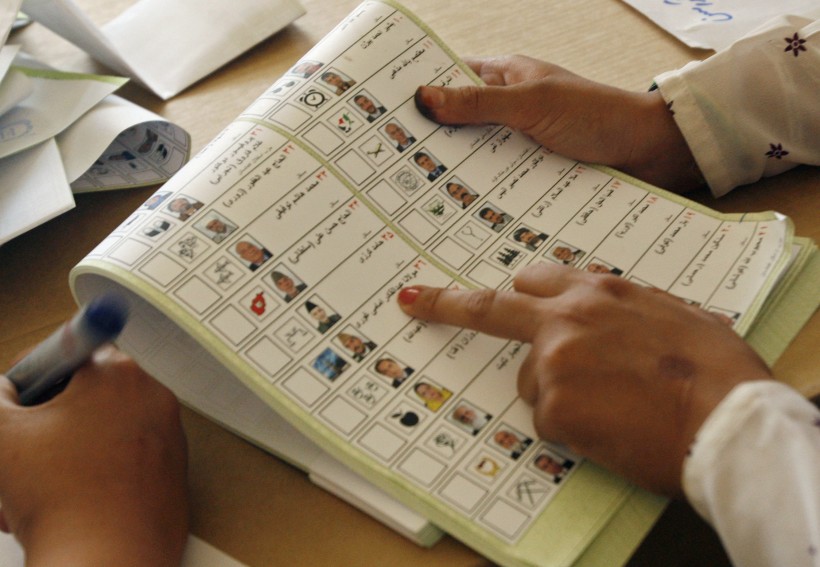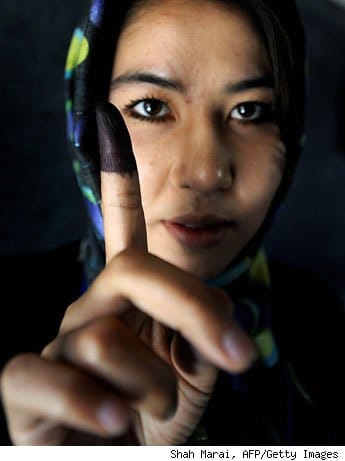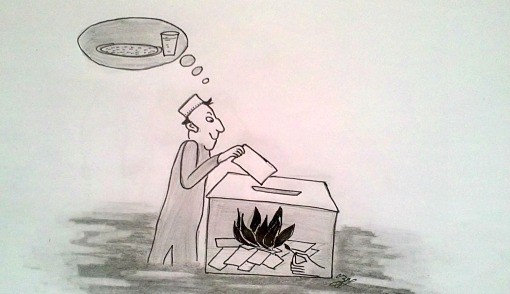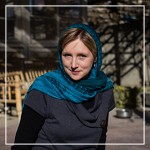The following thoughts combine views expressed in Derailing Democracy in Afghanistan, blog posts written for Afghanelections14.com and observations made over the last decade of international intervention in Afghanistan.
The summer of 2014 has come to be synonymous with electoral chaos in Afghanistan. For many Afghans, the breakdown in the system, exacerbated by continual disputes between the Ghani and Abdullah camps, is the nail in the coffin for Afghanistan’s 21st-century experiment with liberal politics. But stepping back from the focus on elections alone, what of democracy, and of democracy building, in Afghanistan? How will the debacle of 2014 affect prospects for an Afghan democracy, if at all?
According to a recent article in the New York Times, if Ghani and Abdullah can “cooperate fully with the ballot audit, accept the results…and quickly form a functioning government” then there is a chance that they could “put Afghanistan on the path to a real democracy”.[i] What the authors mean by “a real democracy” is unclear, but they appear to assume that if a result can be successfully established then democracy will follow, though surely history and comparative politics demonstrate otherwise, with examples from across the globe. Beyond this, however, is a more troubling phrase that implies the possibility of forming a “functioning government” in a short space of time. It is to this assertion that the following thoughts will attempt to speak.
Democracy (in theory) is all about functioning government. Regular fair elections facilitate the establishment and maintenance of a functioning government, but are institutions designed as a means to a broader end, rather than as ends in themselves. My somewhat crude interpretation of “functioning government” here is one that, at the very least, caters to the basic needs of its citizens and is able to collect tax revenues from them without opposition in order to do so.
Put this way, the definition of a functioning government sounds relatively straightforward: but establishing such a symbiotic relationship between government and all citizens (and the key here is the “without opposition” clause) can take a great deal of time and a great deal more contention.[ii]
Charles Tilly has written at length about the nature of democratisation: for him, the process of making more interactive and “functioning” the relationship between citizen and state. He warns that this process is neither linear nor teleological, in that de-democratisation can occur just as easily if not more so than democratisation, and that a country’s path to democracy can look more like a plate of spaghetti than a decipherable, uni-directional trajectory. This is because state capacity can be over-exerted, provoking citizen reaction or even revolution or civil war. At the other extreme, state capacity can be so weak that few if any public services are provided, also provoking public reaction (whether in the form of protest, revolution or violent insurgency). Tilly argues that these interactions, and all those on the continuum, between citizens and the state, whether peaceful or violent, contribute to a relationship that either moves in the direction of democratisation (for example through successive compromises between the government and opposition groups), or toward de-democratisation (for example through heavy-handed or violent state action against citizens, or civil war). To this end, government becomes more or less “functioning” depending on the direction of travel.
How then does this apply to the Afghan case? One might assume that Afghanistan fits into the ‘weak state capacity’ end of the scale and is perhaps heading toward de-democratisation as the electoral process unravels. But is it that straightforward? While Tilly’s method of characterising the process of democratisation is useful and sheds light on the importance of the state-citizen relationship, it relies on certain definitions of ‘citizen’ and ‘state’ that seem too rigid to apply to the Afghan case. Both terms derive from the 18th-century liberal politics of Locke and J.S. Mill that focus primarily on the rights and duties of individual citizens – whereas for most of recent Afghan history – at least since the beginning of the first Durrani ruler’s reign in 1747 – the connections that have defined the country’s political trajectory have been between entire communities (tribes, subtribes, ethnic groups, families) and successive individual rulers, with little space for either individual citizens or state institutions. This has seen some change, under some regimes, over the years, particularly but not exclusively in urban areas – and yet still many important political deals and negotiations are made between the president and elites on behalf of the groups they supposedly represent. This is not to say that individual citizen interests are not important or should not be protected: but oftentimes they are enveloped within broader community consensus.
Here lies the central problem with democracy-building attempts in Afghanistan thus far. International agencies have approached democratisation much in the same way as Tilly does, albeit with less nuance and sophistication: with a focus on the need to enhance state-citizen connections.
Enhancing service delivery through building capacity in line ministries, funding the activities of civil society organisations, training political parties, and of course putting vast sums of money into holding elections are just some of many examples. And yet in a context where ‘state’ and ‘citizen’ don’t really correlate with their western definitions, this has been difficult. For all the efforts to promote service delivery, services remain inadequate and often attributed to international agencies rather than to the government (see for example the case of the National Solidarity Programme or NSP[iii]). Civil society groups are more often vehicles for the advancement of certain high profile individuals and their ethnic/sub-ethnic groups rather than organisations for the promotion of general public interest. Parties remain ethnically motivated and lack issues-based platforms or ideologies to distinguish one from another. And every election held since 2004 has been a platform for elite negotiation and power-sharing rather than an expression of the will of the people.
Why is this the case? First, because rather than establish wholeheartedly new democratic institutions in the Bonn Process, international and Afghan officials opted for an amalgamation of old and new practices – hence a constitution very similar to that of Zahir Shah in the 1960s, successive Loya Jirgas, and no space for political party activity. This has led to the promulgation of parallel institutional cultures[iv], where old and new political institutions function alongside one another but no new ‘rules of the game’ are fully implemented. Democratic elections have been successively trumped by elite bargaining, at the national and local levels – for example in 2009, 2010 and 2014. Second, are the vast differences between urban and rural connections to the government. While in cities, citizens expect service provision from and relatively ease of access to government bodies, many rural communities have little to no connection with the state and do not desire any: state interference in community affairs is often seen as a negative phenomenon, with the state itself considered predatory and corrupt. Talk of greater connection to the government is often met with quizzical expressions and questions as to why this would be necessary.
And third, there is the question of tax. While gross government revenues (from income tax, sales, rents, etc.) have been increasing in Afghanistan as a percentage of GDP (currently standing at about 11 per cent),[v] these figures do not represent revenues collected from each individual family or group across the country but derive from businesses, rents and elite urban wages. Income tax is charged to individual citizens in Afghanistan but only on wages above 12,500 Afghanis (GBP 135) per month[vi]. For the majority of rural Afghanistan, for whom subsistence farming still occupies the majority of time and labour, there is no income tax. Outside aid and military spending equal approximately 90 per cent of Afghanistan’s USD 20 billion GDP. While this figure does not mean that aid actually accounts for 90 per cent of GDP, and is not widely cited by Afghans, there is nonetheless a widespread perception among rural communities that government revenues are simply supplied by external sources. This creates further distance still between the pockets of individual citizens and families, and the state coffers. Little connection through tax means little accountability – why should it matter how the government spends its money when it’s not our money anyway? Without this critical vehicle as an incentive to hold the government to account, there are few demonstrations, few examples of public outcry, certainly no Arab Spring, and essentially, no democracy. Or at least, no democracy as Tilly or international democracy promoters would define it.
And yet, does democracy need to be defined on these terms? In a sense yes: few have argued successfully with Tilly, for a start – and while context is important, so are the universal principles of universal suffrage and popular control over resource distribution on which modern democratic politics is based.
But it is a fallacy to think that a liberal, western model of democratic politics can simply be carbon-copied in post-conflict areas where state-builders wish to create legitimate, ‘functioning’ governments to keep the peace. Understandings of how democracy emerges should be inseparable from understandings of the local political landscape.
Elections and how they have played out in Afghanistan provide a case in point. Over the last decade, elections have become very much a part of the local political environment in which they are taking place, and have been adapted in many places to fit existing methods of making decisions in the community (for more on this, see, Derailing Democracy in Afghanistan). Bloc voting occurs in many communities, where a suitable candidate is chosen ahead of time and everyone votes accordingly. Voting occurs along ethnic, tribal, family, wider-family, student union, and civil society group lines – and is not always ‘issues-based’. But while some recent reports have pointed this out to be a problem (see here), where the ‘Afghan way’ doesn’t fit with our own, western notions of what elections should look like (i.e. people making their own, independent choices about who to vote for), it could be argued that these practices actually increase the legitimacy of the voting process for many Afghans, who are able to counter the somewhat alien majority-rule idea with a more familiar, consensus-based approach. And this perspective conveniently overlooks the way that bloc voting along ethnic or social group lines is standard practice in our own countries. Of course, there is a need to ensure that people are still able to cast votes that differ from the community consensus – but as long as individual voting rights are protected at the same time as bloc voting occurs, what’s the issue? And does it matter that it occurs along ethnic lines in some cases? Why is this any less representative of people’s interests?
This example also serves as a reminder that the high turnout to the first polls in April 2014 shouldn’t be confused with a public embrace of western liberal principles. Sure, they were a sign that people supported the democratic practice of electing a leader, but elections and liberal democracy are not seen by all Afghans to go hand in hand. Indeed, many people we spoke to in a research project in 2010 (see here) were quite happy with the idea of elections as a means to transfer power, meanwhile associating democracy with western imperialism and the imposition of liberal values on a Muslim nation. Others talked about the need to contain democracy within an Islamic framework. There is still a lot to be debated among Afghans themselves as to what this means in practice, and the kind of government they see functioning best to combine democratic and Islamic practices. While there may be room for international actors to work with civil society and the new government toward improving fiscal accountability mechanisms, access to justice and protection for women’s rights, for example, these issues must be identified as priorities by Afghans themselves. Otherwise, they will simply pay lip service to a superficial set of values that citizens themselves are not prepared to defend.
To draw some tentative conclusions from these thoughts, then: first, democracy is more than anything about functioning government, but that functioning government is difficult if not impossible to establish without contentious interaction between citizen and state over time (and not, as the NYT authors would have us believe, in the blink of an eye following a flawed presidential election).
And second, state-citizen interaction may look different in Afghanistan to western ideals of that interaction – and any international plans to further encourage it need to be firmly rooted in understandings of the local political environment.
References
[i] New York Time, August 25th 2014. ‘Afghanistan’s Moment of Reckoning’. Editorial Board. Available at: http://www.nytimes.com/2014/08/26/opinion/afghanistans-moment-of-reckoning.html?_r=0 [ii] See Tilly, Charles, and Tarrow, Sidney (2007). Contentious Politics. Boulder, CO: Paradigm Publishers; and Tilly, Charles (2007).Democracy. Cambridge and New York: Cambridge University Press. [iii] The NSP was one of the Afghan government’s National Priority Programmes, established in 2003 and spearheaded by then minister for Finance and former World Bank anthropologist Ashraf Ghani, It stipulated the formation of local level elected councils (Community Developmemt Councils or CDCs) that were tasked with deciding on appropriate local development projects that would then be paid for by the Ministry of Rural Rehabilitation and Development (MRRD).. Facilitating Partners – international and national NGOs – had the role of assisting the CDCs to develop proposals for submission to the MRRD. In many cases, project funds were delivered, but in others, there were delays, and problems with the equipment purchased. Furthermore, while most communities were aware that the government of Afghanistan was in some way connected to the NSP project, few actually attributed a specific service-provider role to the government as a result. For more, see Inger W. Boesen, 2004. ‘From Subjects to Citizens: Local Participation in the National Solidarity Programme’. Kabul: AREU, p59 (and throughout). [iv] Kandiyoti, Deniz. 2007. ‘Political fiction meets gender myth: post-conflict reconstruction, “democratization” and women’s rights’ in Cornwall, A., E. Harrisson and A. Whitehead, Feminisms in Development: Contradictions, Contestations and Challenges. London: Zed Books: pp191-200.. [v] According to World Bank estimates, cited in Cordesman, Anthony H. 2013. ‘The Afghan War in 2013: Meeting the Challenges of Transition, Volume II’. Washington, D.C.: Center for Strategic and International Studies. ppVIII-IX and throughout. [vi] 2005 Afghanistan Tax Law, Ministry of Finance.
